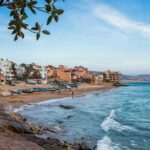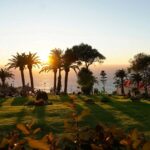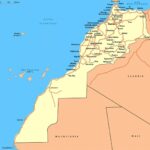Marrakesh, the “Morocco City” as foreign visitors once referred to it, has been a hub of activity for many years. Here tribespeople and Berber villagers bring their wares in search of fortune and pleasure. At its core lies Jemaa el Fna – an open area within the city center that serves as a venue where traditional festivities take place featuring acrobats, drummers, flutists, performers, and carnival attractions drawing crowds from far away areas. An impressive site is El Badi Palace, whose ruins still stand today; another attraction is Saadian Tombs, with fine carvings visible on them, while Koutoubia Minaret remains one of North Africa’s most beautiful Islamic monuments offering great visual allurement.
As soon as you arrive in Marrakesh, you’ll understand why it’s called the Red City. The striking red ochre pigment that covers its walls and buildings can sometimes seem overpowering. Still, there are plenty of other colors too. Like all Moroccan cities, it consists of two halves: the ancient walled Medina, built by the Sultan Youssef Ben Tachfine in the Middle Ages; and the colonial new town, built by the French in the mid-twentieth century. Each has its charms–the Medina with its historic palaces and mansions, labyrinthine souks (marketplaces), and profoundly traditional lifestyle, and the Ville Nouvelle with its chic pavement cafés, trendy boutiques, lovely gardens, and grand boulevards.
Marrakesh is a chic city that attracts rich and famous people from Europe and other places. Even though most of its residents are poor compared to European standards, an increasing number of wealthy foreigners are moving in, and their influence can be seen in the tourist experience.
Marrakesh has always been a hub of trade and commerce, dating back to its origins as a metropolis for the High Atlas Mountain Berber tribes. It served as an essential entrepôt for goods like slaves, gold, ivory, and even “Morocco” leather from Mali’s ancient empires via their great Sahara desert Hub of Timbuktu. These different elements shaped the city’s souks and way of life. Even today, you can still see traces of this nomadic and West African influence in the crowds and performers at Jemaa el Fna.
Despite its great size and the complex maze of souks, Marrakesh is relatively easy to navigate. The vast, open space of the Jemaa el Fna Square is at the heart of the Medina, with the city’s main sights within easy walking distance. To the north lies a vibrant collection of markets and stalls, while just west of the square looms the Koutoubia Minaret – an unmistakable landmark. Avenue Mohammed V cuts through the Medina walls at Bab Nkob and out into Guéliz – a downtown area in the Ville Nouvelle. While you might want to consider hiring a guide to explore the more hidden areas of the marketplace, given a good map, it shouldn’t be necessary.
Marrakech: A brief history
Marrakesh was founded in the early days of Almoravid rule by the first ruler of the dynasty, Youssef Ben Tachfine. It is thought to have started as a camp and market, with a ksour (fortified town) gradually developing around it. The first seven-kilometer of walls was built in 1126–27, replacing an earlier stockade made from thorn bushes. These walls – made of the tibia (the red mud found on plains), mixed with lime to make them stronger – were rebuilt many times over, but they still stand today and are essentially what can be seen now.
The remainder of the Almoravids’ architectural achievements is virtually nonexistent. The dynasty that took over the power – the Almohads – destroyed the city for three days after conquering it in 1147. Still, they kept it as their empire’s capital.
Upon the 1184 accession of the third Almohad sultan, Yacoub el Mansour, to the throne, the city entered a period of great prosperity. New kissarias were constructed to store and sell Italian and Oriental cloths; a new kasbah was built, and a succession of poets and scholars arrived at the court. Under Mansour’s reign, construction began on the great Koutoubia Mosque and minaret.
The empire was on the brink of destruction due to ongoing civil wars by the 1220s. Marrakesh soon followed suit, being plundered and rebuilt multiple times. Its status as capital was taken away in 1269 when the Merenids based in Fez rose to power. Although, from 1374-1386, it became a breakaway state under Abderrahman Ibn Taflusin, a Merenid pretender.
The Saadians took Marrakesh in 1521 and were the last great imperial dynasty. Their most significant figure, Ahmed el Mansour, invaded Mali and seized control of the most lucrative African caravan routes. He used the proceeds to build the El Badi Palace, Marrakesh’s largest and most significant building. The dynasty also left behind the beautiful Saadian Tombs mausoleum.
The Alaouites’ rise to power caused Marrakesh’s standing as the capital city to diminish, with Meknes assuming its place instead. Still, the ancient metropolis remained a significant imperial seat, and sultans regularly kept residence there to shield southern regions from nomadic groups. However, between 1600-the 1800s, it fell back within its medieval walls and experienced an economic dip due to decreased trade activity.
During the past few decades, Marrakesh has regained favor with the Shereefian court and seen a resurgence in fortunes. Moulay Hassan (1873–94) and Moulay Abd el Aziz (1894–1908) ran their governments from here during a bizarre closing epoch of the old ways, accompanied by a final bout of frantic palace building. When the French arrived, Marrakesh gave rise to a short-lived pretender, El Hiba. But, for most of the colonial period, it was run as a fiefdom of its pasha T’hami el Glaoui –the most potent autocratic and extraordinary character of his age.
Since gaining autonomy, the city has experienced significant transformation. People from the Atlas Mountains and beyond have migrated to rural areas; new agricultural approaches are being implemented on Haouz plain while a booming tourism industry is blooming. Marrakech ranks as Morocco’s second most populous location, with just over one million citizens multiplying. It features an active industrial quarter and serves as southern Morocco’s principal market center and administrative hub.
Accommodation in Marrakech
The Medina is the ideal place to stay for budget-conscious travelers, as it offers numerous small, affordable hotels. The area around the Jemaa el Fna mainly concentrates on these accommodations. In addition, most of Marrakesh’s riads – traditional Moroccan houses or mansions – are located in this part of town. Guéliz may be a more convenient option for those needing quick access to transportation hubs like the train station; however, its hotels tend to fall more in the mid-range category price-wise. Meanwhile, upscale lodgings can be found in Hivernage and Semlalia, though these modern buildings with swimming pools lack character. Therefore, it is advisable to make hotel reservations in advance – especially if you’re hoping to secure a room at one of the more popular spots in the Medina during peak travel periods such as Easter or Christmas/New Year.
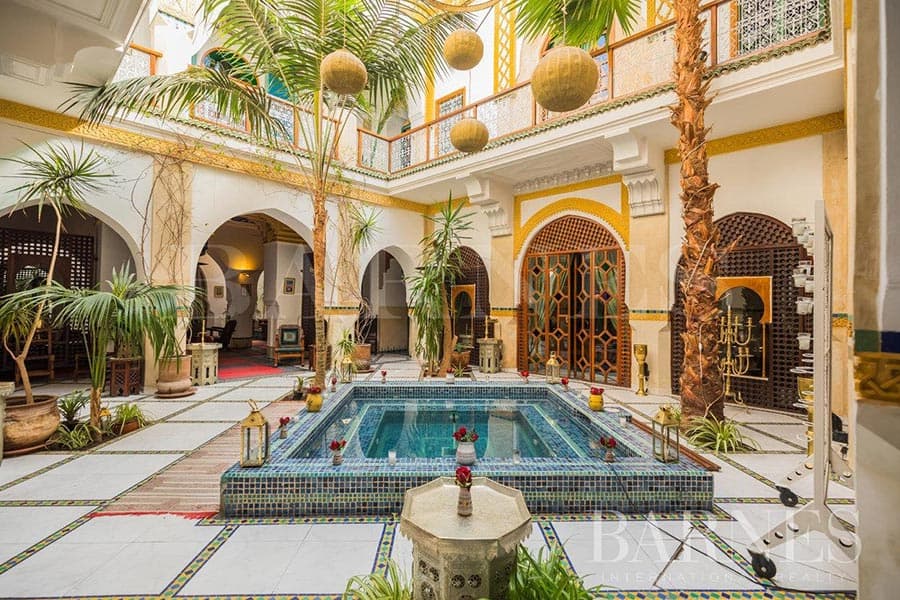
Food and drinks in Marrakech
If you’re looking for a French-style café, bistro, or restaurant, Guéliz and l’Hivernage have the most options. In addition, you’ll find Moroccan food stalls in the Medina at the Jemaa el Fna, many inexpensive café-restaurants, and several upmarket palace restaurants.
Tanjia
If you’re looking for a genuinely authentic Marrakesh dining experience, you must try Tanja. This dish, made with beef or lamb, is simmered in the embers of a bathhouse furnace and is known throughout Morocco for its delicious flavor. Most upmarket restaurants in Marrakesh offer Tanja, but you can also find it at cheaper diners and stalls around the city. To get the best Tanja, be sure to order it in advance.
Entertainment and nightlife in Marrakech
Entertainment and nightlife in Medina typically center around Jemaa el Fna. Your choices are limited for a drink in the Medina; apart from Tazi, you can get a beer – or a cocktail – at Le Tanjia, Café Arabe, and Kosybar. There’s more variety in Gueliz ( New town ); some bars are male-centric, but women should be all right in Chesterfield and bars in hotels such as Essaadi and Sofitel. Plus, Jad Mahal is both an upmarket bar and restaurant. Nightclubs can be fun. However, some at the top end of the market may come across as arrogant; most play a mix of Arabic and western music, but it’s usually the latter that fills the dance floor. None of them gets going until around midnight (some don’t even open until then), and they typically stay open until 3 or 4 am.
Marrakech festivals and events
The bi-annual Festival National des Arts Populaires is a much-anticipated event that draws in people from all over the country and even outside Morocco. The festival showcases some of the best musicians and dancers, with performances across different music genres. Suppose you’re looking for an unforgettable experience filled with great music and an exciting atmosphere. In that case, this is the festival for you!
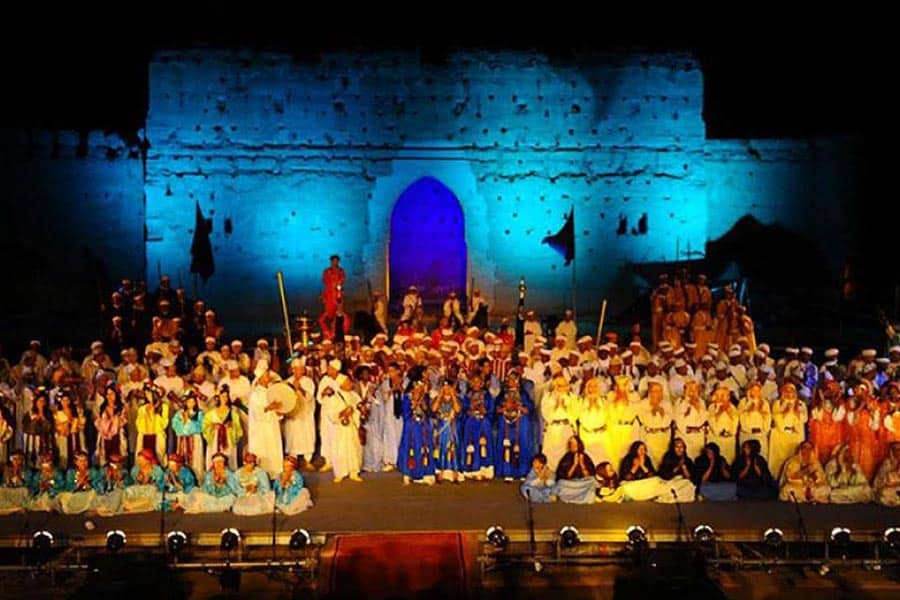
Marrakesh also has an international annual Marathon, held on the third or fourth Sunday of every January. This event attracts runners from all over the world who come to compete in this renowned race. The Marrakesh Film Festival is another much-anticipated event in November or early December. During this time, cinemas across town showcase a variety of films, and large screens are set up in both the El Badi Palace and Jemaa el Fna Square so that everyone can enjoy them.
Every two years, the Marrakech Biennale entertains art lovers from all over with its exceptional visual offerings. At the end of April or the start of May, festivities occur in multiple areas around town. Every March, TEDx Marrakesh takes center stage as a series of thought-provoking talks to occur at Es Saadi hotel within Hivernage.
What to see in Marrakech Medina
Around Place de la Kissaria
The bustling Place de la Kissaria is a popular gathering spot for locals and tourists. Surrounded by beautiful public buildings, the square sits on the northern side of the souks area. The imposing Ben Youssef Mosque dominates the north side of the court – a successor to an original mosque built by Almoravid founders. Completely rebuilt under Almohad rule, today’s structure dates mainly from the 19th century. Visitors can explore this historic site and marvel at its intricate architecture and design.
Almoravid Koubba
The awe-inspiring Almoravid koubba (Koubba Ba’adiyn) is only a short, two-level kiosk. Nevertheless, as the single-standing survivor of this type of architecture in Morocco – except maybe one minaret at Tit near El Jadida – its form provides the basis for all Moroccan designs. Its ornamentations, like pine cones and palms coupled with acanthus leaves, are still seen today on structures such as Ben Youssef Medersa. The window patterns from each side set an example which was then replicated by Almohad and Merenid architects, similar to how merlons were used across domes along with octagons that take shape into squares or stars when viewed inside corners like its own interior design repetition. It could be merely considered a washroom annex off Ben Youssef Mosque. However, its construction gives us our only hint about what that mosque may have looked like before any damage occurred over time.
Discovered only in 1952, the koubba had been previously hidden away during the multiple rebuilds of the Ben Youssef Mosque. As a result, it is located well below today’s ground level; to get to where it was built, you have to go down two flights of stairs. Once down there, you can explore the surrounding areas, including a large water cistern and remains of latrines and fountains used for ablutions—similar to what you would find next to many Moroccan mosques.
Ben Youssef Medersa
The Ben Youssef Medersa is an awe-inspiring koranic school attached to the Ben Youssef Mosque. Here, students learn the Koran through memorization and repetition. The building is a work of art, with intricate zellij tiling, stucco plasterwork, and carved cedar wood adorning its walls and ceilings. It is truly a sight to behold!
The Ben Youssef is a stunning example of Merenid architecture, built by the “Black Sultan” Abou el Hassan in the 1560s. Every surface is adorned with intricate details, whether it’s carved wood, stucco work, or zellij tilework. The quality of craftsmanship is truly astonishing. Suppose you’re interested in seeing some of the best Islamic architecture in the world. In that case, Ben Youssef is worth a visit.

The central courtyard, with its intricately-carved cedar wood lintels eroded almost flat by the harshest elements, is an awe-inspiring sight. Along two sides run broad and resilient columned arcades – likely used to supplement the neighboring mosque’s teaching area. Above them are a few windows for dormitory apartments – reached via stairs from the entry vestibule – where one can gain a fascinating view and attempt to comprehend how over eight hundred students were once housed in this tower! One room has been furnished as it would have when still inhabited, affording guests a precious peek into what life was like for these academicians centuries ago.
At its extremity, the court opens onto a chapel of worship where the adornment, softened outwardly with the city’s common rose hue, is in its best-preserved and most ornate form featuring an abundance of pinecone and palm designs.
The eastern side of Marrakech Medina
Place el Moukef, located at the halfway point between the Ben Youssef Medersa and Bab Debbagh city gates, is more of an intersection than a square. It’s a meeting point for four different routes. If you head east, you’ll find Rue Souk des Fassis, lined by fondouks. And if you go in the opposite direction, you’ll come to Rue du Bab Debbagh. This road passes through the tanneries area on its way to Bab Debbagh. If you go north from Place el Moukef, you’ll find Rue Bab el Khemis. This road leads to another city gate called Bab el Khemis. Or if you go south from the square, you’ll come to Rue Essebtiyne. This route forks after 200m. If you bear right at the fork (from Place el Moukef), you’ll find yourself at Place Ben Salah. This is where the Zaouia of Sidi Ben Salah is located. The Zaouia is a magnificent building with a prominent minaret commissioned by a fourteenth-century Merenid sultan.
The Foundouks
The Medina of Marrakesh boasts a unique architectural style embodied in the Fondouk or caravanserai. Merchants have frequented these inns since ancient times for their commercial ventures at local souks. The structures feature an interior courtyard encircled with stables; upstairs are chambers once occupied by traders from faraway places. Many date back to when the Saadian dynasty reigned (1520–1669) and are adorned with eye-catching woodcarvings and exquisite stucco craft.
Marrakesh’s fondouks are a sight to behold; some have been renovated into charming homes, while others have transformed into bustling businesses. Some even boast tourist-friendly souvenir shops and offer visitors the chance to explore their courtyard interiors without hassle or interruption. It is truly an invitation anyone would be silly not to accept!
If you’re looking for exciting fondouks, Rue Dar el Bacha by the junction with Mouassine is a great place to start. Several Fondouks in this area welcome visitors and offer a unique glimpse into Moroccan culture. If you’re looking for something a bit more off the beaten path, check out the fondouks on Rue Bab Debbagh or Rue Amesfah. And be sure to stop by Terrasse le Medersa restaurant for a bite to eat – it’s located on the terrace of a Fondouk and offers stunning views of the city.
Dar Elbacha
This magnificent palace was commissioned by Pacha Thami El Glaoui, known as the Lord of the Atlas. He ruled over Marrakesh from 1912 to 1956, and this is one of Medina’s most stunning examples of riad architecture. It is dripping with zellige (colorful geometric tilework), intricate white plasterwork, and heavily carved cedar wood lintels. The public could view its grandeur when it opened in 2015 as the Museum of Confluences. This Museum contains exhibitions that change every six months and showcase a variety of art forms from around the world. They are presented extremely professionally within the various salons surrounding the central courtyard.
Notable permanent features at the Museum include the fascinating 12th-century Mediterranean map by Muslim cartographer and explorer Al Idrissi and the beautifully preserved hammam. Head deep into the hammam to find original subterranean brick chimneys that would have heated chambers exposed beneath a glass floor. The Museum also houses an opulent period café specializing in Arabica coffee.
Jamaa Elfna Square
There’s no place in Morocco quite like Jemaa el Fna. It’s a place that effortlessly draws you in and keeps you coming back for more. By day, most of the square is only an ample open space, with a handful of snake charmers bewitching their Cobra snakes with flutes, traditional medicine men (especially in the northeast of the Square) displaying cures and nostrums, and tooth-pullers offering to pluck the pain from out of toothache sufferers’ heads using fearsome pliers—trays of extracted molars attesting to their skill.
As the sun begins to sink in the late afternoon, a new energy buzzes around Place Jemaa el-Fnaa. Just like in France and Spain at dusk, visitors flocking here for an early evening stroll (especially along Rue Bab Agnaou) cause the plaza to gradually come alive with vibrant activities: acrobats doing their tricks, storytellers spinning tales of faraway lands, musicians playing jubilant music – it’s truly a captivating event! Make sure you get involved, too; wander among circles of spectators offering your dirhams as donations from time to time. Then, if all that commotion becomes overwhelming, head up to one of the terraces, such as Cafe du Grand Balcon, for some respite and awe-inspiring views over this electrifying space packed full of people eager to hear more stories or join any number of musical performances on offer.
The Souks
Venturing into the vast and seemingly impossible-to-navigate souks north of the Jemaa el Fna for the first time can be overwhelming. However, it becomes apparent that the area is relatively compact upon closer. A long-covered street called Rue Souk Smarine runs through the middle of the market, eventually splitting off into two lanes – Souk el Attarin and Souk el Kebir. Most of the individual souks are located off these two main streets: small alleyways or courts devoted to specific craftsmanship where you can often watch part of the production process.
Suppose you’re staying for a few days. In that case, you’ll probably want to return to the souks often – and this is an excellent way of taking them in, focusing on a couple of specific crafts or products instead of being overwhelmed by everything. Of course, to get a feel for the general layout, you should walk around the whole area once with a guide. Still, it’s optional: with a good map, you can quickly get around the souks on your own, and besides, getting lost is all part of the fun.
Exploring the enchanting souks of this city should be noticed. Optimal times to visit include mornings (9–11 am) and just before dusk, around 4-5 pm, when traders battle it out in auctions for goods. Inevitably stalls close after dark, yet there is still much wonderment as you peruse their intricate doorways and archways unhindered; those that remain open until 7 or 8 o’clock can often provide excellent buying opportunities towards day’s end!
The most straightforward way of getting to the bustling Jemaa el Fna market is by taking Rue des Banques (check out the map). As you turn left onto Terrasses de l’Alhambra restaurant, a lane will lead directly toward Souk Ableuh. This area is renowned for its abundance of olive stalls – keep heading through. Eventually, you’ll arrive at an impressive archway that marks your arrival on Rue Souk Smarine!
The history of Jamaa El Fna
It is still being determined when the Jemaa el Fna transpired, how it came to be, or what its name signifies. A frequently utilized interpretation would be “gathering of the deceased,” a title that could allude to this area’s past where criminals and rebels were publicly presented – even up until the early 19th century, executions occurred here. Conversely, it might signify a “Mosque of emptiness” (Jemaa meaning both Mosques and assembly) which recollects an abandoned Saadian plan for constructing a grandiose mosque in this location previously.
The Jemaa el-Fnaa is a public square and marketplace in Marrakesh’s Medina quarter (old city). It remains one of the busiest squares in Africa and the world. The day starts as traders unpack their goods from nearby shops, string up makeshift stalls or spread mats on the ground to display almonds, dates, spices, and other local produce. By midday, it becomes difficult to move through the crowd: water sellers with their decorated leather skins; women offering Henna tattoos; acrobats, snake charmers, and magicians competing for space with dentists advertising “Toothpulling – 5 dirhams”!
Street food in Jamaa El Fna Square
Even though you might not be interested in eating at them, you should stroll down the path of food stalls on the Jemaa el Fna. The view is great in the evening when lanterns are lit. You can find Couscous and pastilla, spicy merguez sausages, Harira soup, salads, fried fish, and stewed snails (towards the eastern side). To join in, grab a seat on one of the benches. You can ask how much a plate costs and order whatever you’d like. It’s best to avoid places trying to get you out of your money by overcharging without telling you first.
The food stalls that Moroccans frequent are always of better quality than those that only serve tourists. If you want a drink with your meal, the vendors will send a boy to get it for you. On the southern edge of the food stall area is a row of vendors selling a hot, spicy galangal drink (Khoudenjal). This drink is said to be an aphrodisiac and is usually taken with a portion of nutty cake. Both sides of the food stall area have orange, and grapefruit juice stalls open all day. However, check the price first and insist on pressing the juice before you. Often, if they pull out a bottle of ready-pressed juice, it will be watered down or mixed with squash.
The Southern part of Marrakech Medina
Lying south of Jemaa el Fna is an area that differs vastly from the region north, commonly characterized by its spaciousness and housing Dar el Makhzen (the royal palace), a kasbah (ancient inner fortification) as well as the Mellah (a former Jewish district). Undoubtedly, two spots that should not be missed are El Badi – Ahmed el Mansour’s defunct castle – and Saadian Tombs sheltered in front of Kasbah Mosque. Additionally worth viewing are Bahia Palace and nearby museums such as Tiskiwin and Dar Si Said.
The Bahia Palace
The Bahia Palace was built in 1866–7 for Si Moussa, a formerly enslaved person who had risen to become Moulay Hassan’s chamberlain and grand vizier. When Hassan died while returning from a tax-collecting expedition in 1894, Bou Ahmed, who served as chamberlain under Moulay Hassan, took control of the state by declaring Hassan’s fourteen-year-old son Moulay Abd el Aziz sultan in his place and naming himself as grand vizier. He began enlarging the Bahia Palace (meaning “brilliance”) in the same year as his coupd’état, adding a mosque and a vegetable garden. His servants ransacked the palace when he died, but it was restored soon after. During French rule, it housed their Resident General.
The Small Riad
As you enter the palace from the west, you’ll pass through an arcaded courtyard and come to a small riad (enclosed garden). This is part of Bou Ahmed’s extension, decorated with beautiful carved stucco and cedarwood. There are salons on three sides, and the eastern salon leads to the council room. From there, you’ll go through a vestibule (where you can pause to look up at the lovely painted ceiling) into the great courtyard of Si Moussa’s original palace. The rooms around this courtyard are also worth checking out for their painted wooden ceilings.
The Big Riad
Beyond the majestic courtyard lies a riad, nestled within Si Moussa’s palace like an anomaly of beauty. Its air is dense with sweet-smelling fruit trees and birdsong, creating melodies to soothe even the most troubled soul. To its east and west are halls adorned by exquisite zellij fireplaces and painted wooden ceilings – each more breathtaking than before! Finally, you can access Lalla Zinab’s private apartment, built in 1898 for her husband, Ahmed. It has marvelous stained glass windows and intricately carved stucco on the ceiling that will surely drop your jaw.
The Saadian Tombs
Behind the royal palace, before Saadian times, there was likely a burial ground. The earliest tomb dates from 1557, and Sultan Ahmed el Mansour erected much of what is seen here today – around this time as well Ben Youssef Medersa and El Badi Palace were built. After the arrival of the Saadians, several Marrakshis continued to be interred in these mausoleums until 1792 when “mad sultan” Moulay Yazid had his last resting place constructed within them; he was appointed by Sidi Mohammed but embarked on numerous revolts against him before going head-to-head with Spain in an unsuccessful war effort. When supporters rallied for his brother’s cause back home at Marrakesh, they met resistance as Moulay Yazid quashed their rebellion through massacre tactics; shortly after taking control, though, a fatal bullet wound felled him during counterattack retaliation from rebels who had regrouped outside city walls.
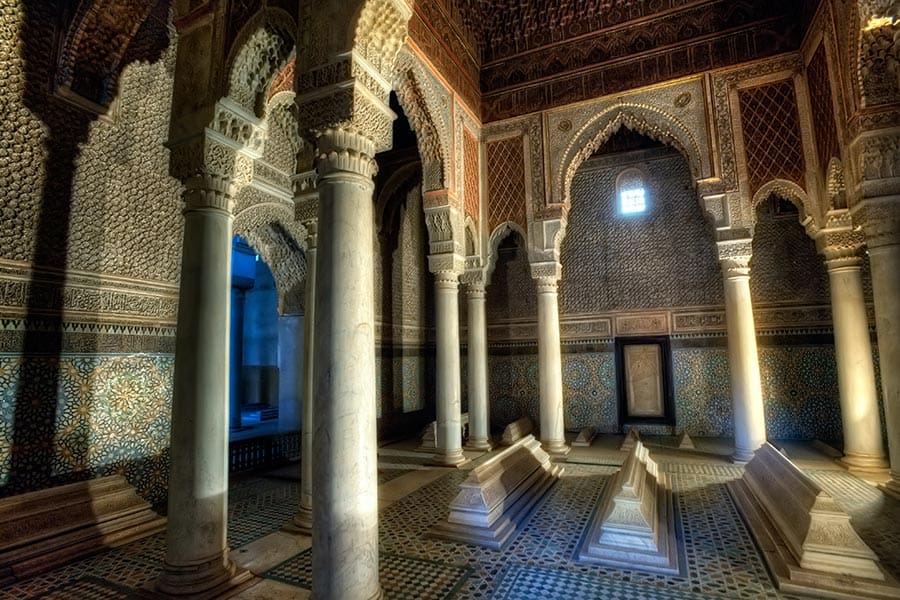
The tombs were spared from plundering by the Alaouite sultan Moulay Ismail, who probably feared that he would incur bad luck if he defiled them. Instead, he blocked all access to them except for an obscure entrance from the Kasbah Mosque. Although the tombs had been forgotten and left to ruins, they were rediscovered in 1917 by a French aerial survey. A passageway was then built to give people access to them.
El Badii Palace
Though now in ruins, El Badi Palace was once an incredibly lavish and grand structure. After becoming Sultan in 1578, Ahmed el Mansour commissioned the construction of a new palace. The money for the palace came from the enormous ransom paid by the Portuguese after the Three King’s battle. His seventeenth-century successor Moulay Ismail took over ten years to strip the palace of all its valuable materials. Still, even today, the place has a sense of luxury and grandeur. Today, you see the ceremonial part of the palace complex, which was designed on a grand scale for the reception of foreign ambassadors. It was not meant for everyday living.
The lavish scale of the palace, with its beautiful sunken gardens and expansive ninety-meter pool, is unrivaled. The mysterious traces of zellij and plaster that remain invoke a decor that was probably as abundant as that of the Saadian Tombs. The most intriguing account of the palace concerns its grand opening ceremony – a fabulous event attended by ambassadors from several European countries and all the sheikhs and caids in the kingdom. As Ahmed surveyed the scene, he turned to his court jester for advice on the new palace. “Sidi,” the man replied with a smile, “this will make a magnificent ruin.”
The Central Court
The original entrance to the palace was in the southeast corner. However, today you enter from the north through the Green Pavilion. You emerge into a vast central court over 130m long and wide. In its northern corner, you can climb up to get an overview of the ramparts and see storks nesting atop them.
The central court has four sunken gardens, two on the northern and two on the southern side. Two pools separate the two gardens on each side. In addition, there are four smaller pools in the four corners of the court, which are constructed on a substructure of vaults to allow water circulation through the pools and gardens. When the pools are filled – during June’s folklore festival, for example – they are an incredibly majestic sight.
The Summer Pavillion
Its foundations are the only surviving part of the Crystal Pavilion, located east of the courtyard. The huge Koubba el Hamsiniya (The Fifty Pavilion), which the sultan used for state occasions, was situated on the opposite side.
The Stables and prison
Just to the right of the room housing the Minbar, there are ruins of the palace stables. Beyond them, leading towards today’s royal palace walls is a series of dungeons that were used as a state prison until recently.
The Minbar
The original Minbar from the Koutoubia Mosque is now housed in a pavilion in the southwest corner of the central courtyard. You can see it for an additional fee. This Minbar was once one of the Muslim world’s most celebrated works of art. The Minbar was commissioned from Cordoba in 1137 by the last Almoravid King, Ali Ben Youssef. It took eight years to complete and was covered with exquisite inlay work, of which only patches remain today. When the Almohads took over the power, they installed the Minbar in the Koutoubia Mosque. It remained there until it was removed for restoration in 1962 and eventually brought to its current location. Public members are only sometimes allowed to walk around it to inspect the surviving inlay work. Still, if you show a particular interest, you may be able to persuade the gardien to let you do so. Unfortunately, photography is usually not allowed inside.
The Koutobia Mosque
The Jemaa el Fna stands bare, strikingly contrasting with the majestic Koutoubia Minaret that soars high above. Awe-inspiring in its grandeur of around 70 meters and visible from far distances on clear mornings, this is one of three great Almohad towers (the others being Hassan Tower in Rabat and Giralda in Seville) -and it’s also the most intact. Moreover, its appealing dimensions – five times higher than wide– exemplify traditional Moroccan architecture.
Under the rule of Sultan Yacoub el Mansour (1184–99), construction on the minaret likely started shortly after the Almohad victory in the city, around 1150. It has many characteristics that became customary to Moroccan architecture – a wide strip of ceramic insets near its peak, pyramid-shaped merlons with battlements over it, utilization of Darj w Ktaf (“cheek and shoulder”) as well as other decorations – thus setting up an alternating patterning along different faces. The uppermost floor is similar, while the lower two are strikingly varied. On the middle niche’s southeast side was erected a semicircle featuring tiny lobed arches, which later developed into a common decorative element for gates within the Almohad realm. The three great copper balls topping the tower are said to have been created by a woman who broke her fast during Ramadan. Yacoub el Mansour’s wife is thought to have made them out of gold as an act of penance. These balls are now seen as a way to keep thieves away due to their supernatural powers.

Gazing up at the towering minaret, one is struck by its unique shape. Its stones gradually decrease in size as they reach the summit. This oddity may seem strange today, but it was intentional when it first stood proudly with all of its plaster and painted intact atop Kasbah Mosque. In 2000, plans to restore this grand structure were discussed; however, authorities settled for a thorough cleaning, which made quite an impact once illuminated during dark hours. Excavations around Koutoubia revealed more secrets, such as a mosque built before the tower’s foundation whose alignment had needed adjustment upon completion due to being misdirected from Mecca’s holy destination!
The New Town (Ville Nouvelle)
The bustling city of Marrakesh radiates out from its commercial center, Guéliz. Though it may not be brimming with attractions, one unmissable spot is the Majorelle Garden. To the south of Guéliz lies the Hivernage district, which was built as a garden suburb and now houses most of the city’s newer tourist hotels. Further away to the northeast is Marrakesh’s Palmeraie.
Gueliz
The beating heart of modern Marrakesh, Guéliz, has an electric atmosphere that the sleepy old Medina cannot match. Its main thoroughfare, Avenue Mohammed V, runs down to the Koutoubia Mosque, and it’s on and around this boulevard that you can find the city’s best upmarket shops, restaurants, and pavement cafés. Its junctions form the Ville Nouvelle’s main centers of activity: La Place de la Liberté, with its beautiful fountain; Place 16 November by the grand post office; and Place Abdelmoumen Ben Ali in the epicenter of Marrakesh’s bustling shopping district. Looking back along Mohammed V Avenue from Guéliz towards the Medina on a clear day (and there are many), you should see The Koutoubia rising in majesty against the backdrop of Atlas mountains beyond.
Majorelle Garden
The Majorelle Garden, more aptly known as the Jardin Bou Saf, is an artistically designed twelve-acre botanical paradise developed in the 1920s and 1930s by acclaimed French painter Jacques Majorelle (1886–1962). Years later, it became owned by the renowned fashion designer Yves Saint Laurent, who honored his memory when he passed away in 2008. His ashes were scattered throughout this remarkable garden which also contains a memorial dedicated solely to him; furthermore, the street adjacent to its entrance has been renamed after him.
The peacefulness in the garden is augmented by abundant groves of bamboo, mini palm, agave, a cactus plot, and pools blanketed with lilies. The Art Deco pavilion, at its core, has been painted an eye-catching cobalt blue – according to Majorelle, it was supposedly the color donned by French laborers’ uniforms; however, this hue seems to have become more vivid due to Moroccan sun rays. It presents a gorgeous contrast against all plants – from multihued bougainvillea shrubs, lines of vivacious orange nasturtiums, and pink geraniums – plus striking colors used for pergolas along with concrete pathways such as pinks, lemon yellows, or apple greens. The enduring sound is the chatter of common bulbuls, flitting among the leaves of the palm trees, and the pools attract other bird residents, such as turtle doves and house buntings. The garden became more famous abroad when Yves Saint Laurent featured it at London’s 1997 Chelsea Flower Show.
Do not listen to the taxi drivers waiting outside when exiting the garden. They are part of a cartel and will charge you more than necessary. The answer is to walk down the main road and hail a cab there.
The Berber Museum
In Majorelle’s former atelier, situated within the pavilion, a Berber Museum starts with an exposition regarding Morocco’s indigenous people group: their culture and dialects, as well as where in that country they are from. From there, it moves (in the room after) to the traditional handiwork of these folks, encompassing fabrics and rug-weaving plus tools used for producing them together with rendered items. There is even a magnificent albeit slightly unsteady wooden Minbar (Mosque pulpit) from the nearby Atlas Mountains ornamented by one-of-a-kind Berber decorations! The next chamber has jewelry displayed, all crafted out of silver, seeing how gold happens to be deemed blighted according to this population’s customs. Lastly, you can find costumes borrowed from various areas across Morocco exhibited inside the last compartment.
Yves Saint Laurent Museum
The house of Yves Saint Laurent is synonymous with Marrakech. His home is one of the most visited places in Marrakech. The blue masterpiece and exotic planting at Majorelle Gardens were his home for many years. In addition, he had a love affair with Morocco, with the colors and textures of the country.
The fresh Museum (just outside Majorelle Garden) demonstrates his career. It’s an area that drags you into the realm of YSL. The primary presentation room in the exhibition hall (which doesn’t permit photographs) is stunningly beautiful. Not allowing pictures implies this space remains a pleasant amazement for guests to experience without interruption. I was, fortunately, ready to investigate with tranquillity – having enough distance and time around me so I could get close up to each bit of attire to observe every detail! Artistic expression from diverse cultures is unmistakably present in YSL’s captivating works; they’re genuinely remarkable masterpieces worth seeing live at least once!
The fabrics are just stunning, detailed, and so richly colored. The mannequins are elegant, wearing clothes with so much history and pieces that have influenced the whole of fashion. Along with clothing, YSL’s prints and sketches are on display. I was so envious of his sketches, and there’s such a sense of movement and life in his sketches. He could perfectly capture a creation in a simple sketch.
The Museum was designed by Studio KO, an architecture studio based in Hong Kong. The firm said, “The outside of the building is intended to evoke the weft and warp of fabric while the interior is designed to evoke the lining of a couture jacket, velvety, smooth, and radiant.”
Unlock the story of YSL and experience it firsthand in his Marrakech museum. Take a break from the hustle and bustle at Le Studio Cafe, conveniently located right by the courtyard entrance. Enjoy an array of refreshments as you admire stunning views of what lies beyond its walls, then venture inside to explore this legendary label’s heritage further!



